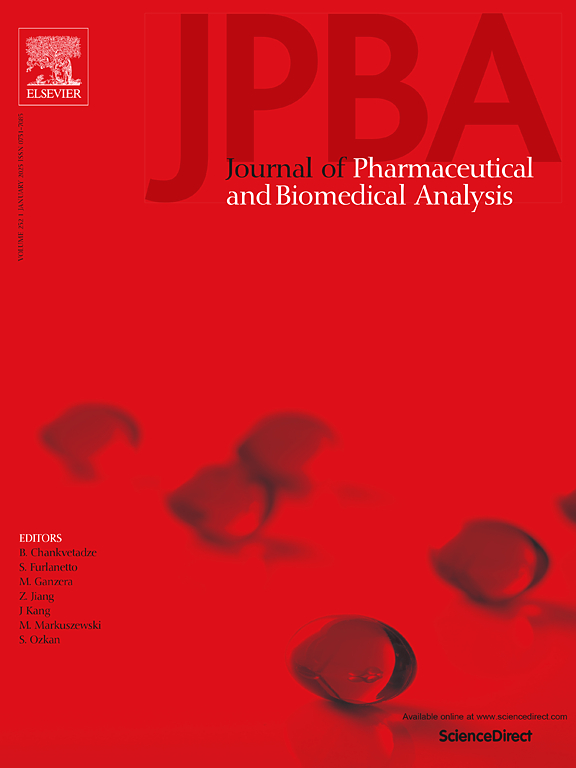Advancing therapeutic monoclonal antibody analysis: A sequential injection lab-on-valve approach
IF 3.1
3区 医学
Q2 CHEMISTRY, ANALYTICAL
Journal of pharmaceutical and biomedical analysis
Pub Date : 2025-07-09
DOI:10.1016/j.jpba.2025.117060
引用次数: 0
Abstract
Advancements in automated flow-based techniques have significantly improved precision, efficiency, and sustainability in the analytical field. Among these, sequential injection lab-on-valve (SI-LOV) offer a miniaturized and resource-efficient approach for high-throughput analysis. In this work, the feasibility of a fully automated SI-LOV system coupled with a miniaturized spectrometer was investigated for therapeutic monoclonal antibodies (mAbs) assessment. Six mAbs, including Rituximab (RTX), Trastuzumab, Cetuximab, Nivolumab, Panitumumab, and Ramucirumab, were analyzed. Quantification of mAbs, particularly RTX, was achieved with high accuracy, linearity (0.25–1.25 mg mL−1, R > 0.996), and low limit of detection (0.09 mg mL−1). Second-order derivative spectroscopy (245–300 nm) enabled qualitative assessment via well-resolved peaks, mainly related to phenylalanine, tyrosine, and tryptophan present in mAb structures. Mass-based calibration, ensuring consistent quantification regardless of calibration by sample concentration or injection volume, was possible for sample mass > 5 µg. The study of SI-LOV parameters ensured good repeatability (1.8 %), reproducibility (2.3 %), and rapid analysis (ca. 110 s per determination). RTX concentration was estimated for a surrogate cell culture supernatant with good accuracy (> 96 %), demonstrating its potential for application in biopharmaceutical workflows for high throughput mAb analysis. These findings highlight the SI-LOV system's effectiveness as a robust and automated platform for mAb analysis, offering significant potential for routine quality control, high-throughput analysis, and process monitoring in the biopharmaceutical industry.
推进治疗性单克隆抗体分析:顺序注射实验室-瓣膜方法
自动化流动技术的进步显著提高了分析领域的精度、效率和可持续性。其中,顺序进样阀上实验室(SI-LOV)为高通量分析提供了一种小型化和资源高效的方法。在这项工作中,研究了全自动SI-LOV系统与小型化光谱仪相结合用于治疗性单克隆抗体(mab)评估的可行性。分析6种单抗,包括Rituximab (RTX)、Trastuzumab、Cetuximab、Nivolumab、Panitumumab和Ramucirumab。单克隆抗体的定量,特别是RTX,具有高精度,线性(0.25-1.25 mg mL−1,R >;0.996),低检出限(0.09 mg mL−1)。二阶导数光谱(245-300 nm)通过高分辨峰进行定性评估,主要与单抗结构中的苯丙氨酸、酪氨酸和色氨酸相关。基于质量的校准,无论通过样品浓度或进样量校准,都可以确保一致的定量,样品质量>; 5 µg。SI-LOV参数的研究确保了良好的重复性(1.8 %),再现性(2.3 %)和快速分析(每次测定约110 s)。用代细胞培养上清液估计RTX浓度,准确度较高(>;96 %),证明了其在生物制药工作流程中用于高通量单抗分析的潜力。这些发现突出了SI-LOV系统作为单抗分析的强大自动化平台的有效性,为生物制药行业的常规质量控制、高通量分析和过程监控提供了巨大的潜力。
本文章由计算机程序翻译,如有差异,请以英文原文为准。
求助全文
约1分钟内获得全文
求助全文
来源期刊
CiteScore
6.70
自引率
5.90%
发文量
588
审稿时长
37 days
期刊介绍:
This journal is an international medium directed towards the needs of academic, clinical, government and industrial analysis by publishing original research reports and critical reviews on pharmaceutical and biomedical analysis. It covers the interdisciplinary aspects of analysis in the pharmaceutical, biomedical and clinical sciences, including developments in analytical methodology, instrumentation, computation and interpretation. Submissions on novel applications focusing on drug purity and stability studies, pharmacokinetics, therapeutic monitoring, metabolic profiling; drug-related aspects of analytical biochemistry and forensic toxicology; quality assurance in the pharmaceutical industry are also welcome.
Studies from areas of well established and poorly selective methods, such as UV-VIS spectrophotometry (including derivative and multi-wavelength measurements), basic electroanalytical (potentiometric, polarographic and voltammetric) methods, fluorimetry, flow-injection analysis, etc. are accepted for publication in exceptional cases only, if a unique and substantial advantage over presently known systems is demonstrated. The same applies to the assay of simple drug formulations by any kind of methods and the determination of drugs in biological samples based merely on spiked samples. Drug purity/stability studies should contain information on the structure elucidation of the impurities/degradants.

 求助内容:
求助内容: 应助结果提醒方式:
应助结果提醒方式:


